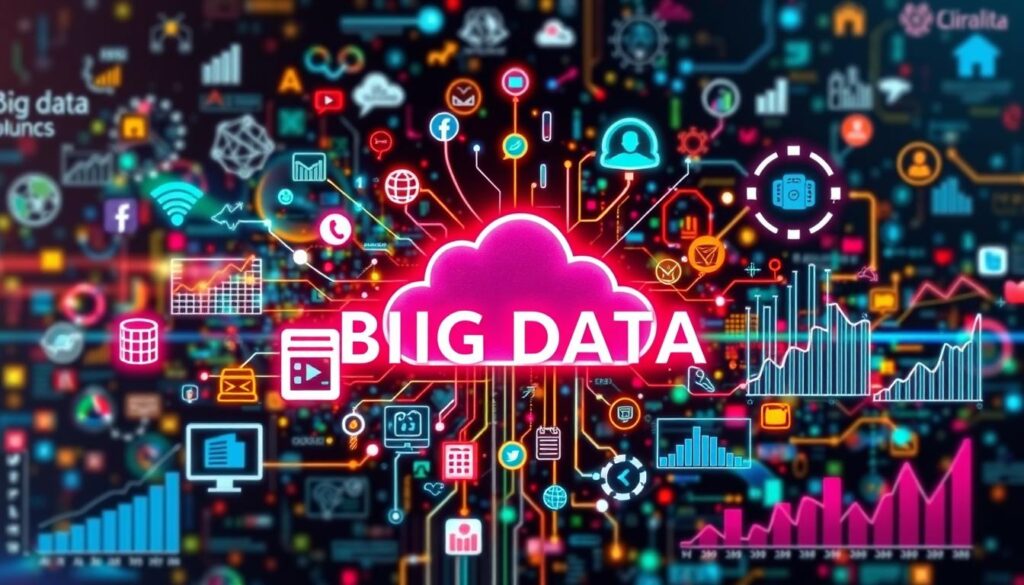In today’s world, big data analytics is key for businesses. It helps find valuable insights in big data sets. This is true for healthcare, retail, finance, and more.
Big data analytics uses four main methods to analyze data. It looks at both structured and unstructured data. This includes web data, social media, and more. By using business intelligence tools, companies can understand their operations better.
Big data analytics might seem hard, but it’s worth it. It helps companies work faster and smarter. This leads to more profits and success in the long run. Knowing how to use big data analytics is now crucial for businesses.
Key Takeaways
- Big data analytics uses advanced techniques to find insights in big data sets across various industries.
- The four key data analysis methods – descriptive, diagnostic, predictive, and prescriptive – are the foundation of big data analytics.
- Big data analytics can provide organizations with increased speed, agility, and smarter decision-making, leading to improved profitability and long-term success.
- Embracing big data analytics has become a critical skill for businesses as the demand for data-driven insights continues to grow.
- Big data analytics is transforming the way companies operate, optimize processes, and enhance customer experiences.
What is Big Data Analytics?
Big data analytics is about looking at lots of data to find trends and patterns. This helps companies make smart decisions. It’s fast, so businesses can stay ahead of the competition.
Definition and Characteristics
Big data has five key features: volume, velocity, variety, variability, and value. It’s complex, needing new tech and skills to understand.
Examples Across Industries
In health care, big data analytics is crucial. It deals with vast amounts of patient data. This includes records, insurance, and more. It helps doctors make quick, accurate diagnoses.
“Big data analytics encompasses methods and tools used to process high-volume, varied data sets from sources like web, mobile, social media, and IoT devices.”
Why is Big Data Analytics Important?

In today’s world, big data analytics is key for businesses. The amount, speed, and types of data are growing fast. Companies see the importance of big data analytics in finding valuable insights, making better decisions, and driving new ideas.
Benefits of Big Data Analytics
The benefits of big data analytics are huge and can change how organizations work. Here are some main advantages:
- Cost Reduction: Big data analytics can find and fix waste, saving money and using resources better.
- Improved Product Development: By looking at customer data and trends, companies can make products that people really want.
- Better Strategic Decisions: With data insights, businesses can make smarter choices, leading to better results.
- Enhanced Customer Experience: Big data helps understand what customers like, so companies can give them what they want.
- Effective Risk Management: It helps spot and deal with risks, making businesses more stable and secure.
- Transformative Applications: Big data analytics is changing many fields, like healthcare, education, entertainment, and banking, making them more efficient and innovative.
As big data analytics becomes more important, companies that use it will do well in the digital world.
Types of Big Data Analytics

In the world of big data, there are four main types of analytics. These are descriptive, diagnostic, predictive, and prescriptive analytics. Each type offers unique insights and benefits to businesses looking to use their data wisely.
Descriptive Analytics is about data that’s easy to understand. It helps create reports and visualizations. This type answers “What happened?” by looking at past data and finding patterns. For example, Spotify uses it to show its most popular songs and artists.
Diagnostic Analytics helps figure out why problems happen. It digs deep into data to find the root causes. The Dow Chemical Company used it to save nearly $4 million by using space better.
- Predictive Analytics uses past and present data to predict the future. It’s powered by AI and machine learning. Companies like PayPal use it to spot and stop fraud.
- Prescriptive Analytics offers solutions to problems. It uses AI to analyze data and suggest actions. Airlines, for example, adjust their prices automatically to make more money.
| Type of Analytics | Description | Example |
|---|---|---|
| Descriptive Analytics | Summarizes past data and identifies patterns or trends | Spotify’s analysis of popular songs, artists, and playlists |
| Diagnostic Analytics | Identifies the root causes of issues or behaviors | Dow Chemical’s consolidation of underutilized space |
| Predictive Analytics | Uses AI, machine learning, and data mining to make predictions | PayPal’s fraud prevention based on historical payment data |
| Prescriptive Analytics | Provides solutions and recommendations based on data analysis | Airlines’ automatic adjustment of flight fares based on various factors |
Knowing about the different types of big data analytics helps businesses make better decisions. They can improve operations and stay ahead in the market.
Big Data Analytics Tools
In today’s world, we need advanced tools to handle big data. Luckily, the field has grown a lot. Now, data analysts have many easy-to-use software systems to choose from. These include open-source tools like Apache Hadoop and Spark, and cloud-based platforms like Qubole and Xplenty.
Popular Tools and Technologies
Some top big data analytics tools and technologies are:
- Apache Hadoop – an open-source Java-based framework for distributed storage and parallel data processing of large datasets
- Apache Spark – an open-source distributed data processing engine that excels at in-memory computing, supporting SQL queries, stream processing, and AI/ML applications
- Cassandra – an open-source distributed database designed to handle petabytes of data with high scalability
- Qubole – a cloud-based big data analytics platform that lowers the cost of cloud computing by up to 50% and supports multi-cloud services
- Xplenty – a data pipeline solution provider for sales, marketing, and support functions, requiring minimal investment in hardware and software
- MongoDB – a popular NoSQL database among developers due to its multi-programming language support, including Python, JavaScript, and Ruby
- Storm – a real-time data processing tool used by tech giants like Twitter and Zendesk, capable of handling up to 1 million messages of 100 bytes per second on a single node
- SAS – a comprehensive analytics platform that enables users to mine, manage, extract, or update data in various formats from different sources, offering a cloud-based solution
- Datapine – a business intelligence and data extraction tool that provides predictive analytics and AI-powered automation
- RapidMiner – a visual workflow design tool for data analytics, commonly used in industries like ed-tech and research
These tools are just a few examples of what’s available today. Knowing how to use them well is key for a career in big data analytics.
| Tool | Key Capabilities | Notable Use Cases |
|---|---|---|
| Apache Hadoop | Distributed storage, parallel processing | Used by tech giants like Amazon, Microsoft, and IBM |
| Apache Spark | In-memory computing, SQL queries, stream processing, AI/ML | Set a new record by processing 100 TB of data in 23 minutes, outperforming Hadoop |
| Qubole | Cloud-based analytics, 50% cost reduction, multi-cloud support | Enables enterprises to make strategic decisions at scale |
| Tableau | Data visualization, ad-hoc querying, real-time monitoring | Adopted by leading organizations for critical KPI viewing and data analysis |
As data grows, so does the need for big data analytics tools and big data technologies. They help us find important insights and make smart decisions. Learning to use these big data software solutions is vital for anyone in data analysis or business.
Data Sources for Analytics

Organizations have many data sources for big data analytics. These include media data, customer insights, business processes, and databases. Using these sources, businesses can understand their customers, operations, and performance well.
Media Data
Media data is a key source of big data. It includes social media posts, editorial content, podcasts, and search engine data. This data gives real-time insights into what customers like and do, helping businesses make better decisions.
Customer Insights
Businesses need to analyze customer data from different places. This includes demographic info, CRM data, and web behavior. By using customer insights, businesses can meet customer needs better, offer personalized services, and improve the customer experience.
Business Processes
Big data analytics can track how business teams perform, especially in big companies with remote workers. It looks at metrics like social media complaints, response times, and PR campaign status. This helps improve team productivity and marketing efforts.
Databases
Companies have invested in data storage facilities called data warehouses. These hold various data types, like emails, accounting records, and marketing databases. Analyzing this data helps businesses find valuable insights and make informed decisions.
| Data Source | Examples | Key Benefits |
|---|---|---|
| Media Data | Social media, editorial content, podcasts, search engine data | Provides real-time insights into customer preferences and emerging trends |
| Customer Insights | Demographic data, transactional data, web behavior data | Enables personalization and better understanding of customer needs |
| Business Processes | Social media performance metrics, PR campaign timelines | Helps monitor and optimize team productivity and marketing initiatives |
| Databases | Company emails, accounting records, marketing and sales contact databases | Serves as a centralized repository for comprehensive data analysis |
By using these different data sources, organizations can understand their customers, operations, and performance well. This helps them make informed and strategic decisions.
Big Data Analytics

In today’s world, data science is key. It helps companies use big data to find important insights. This way, marketing teams can make better plans that improve customer service and marketing.
Data analytics is at the core of this change. It uses advanced tools to find patterns in big data. This helps marketing teams predict and make better choices, staying ahead of rivals.
| Data Analytics Techniques | Description |
|---|---|
| Descriptive Analysis | Helps understand what has occurred in the past |
| Diagnostic Analysis | Builds upon descriptive analysis to determine why events occurred |
| Predictive Analysis | Predicts future trends using machine learning and AI techniques |
| Prescriptive Analysis | Uses predictive analytics to strategize future events effectively |
The success of data analytics depends on good data. Companies use many data sources to understand their market and customers better.
To make the most of big data analytics, businesses need the right tools. Tools like Tableau Public and Python help process and analyze big data. This turns data into useful insights that help grow and innovate.
“The true value of big data lies in the insights it can provide, not just the data itself.”
Getting Started with Big Data Analytics
If you’re thinking about a career in big data analytics, start with a solid education. Many schools offer degrees in statistics, mathematics, computer science, or information technology. These programs teach the technical and analytical skills needed to succeed in this fast-changing field.
But there’s more than just degrees. Certifications in data science and machine learning are also valuable. Online programs, like the Data Science and AI program from the Institute of Data, offer practical skills and real-world experience. They help you stay competitive in the job market.
Skills for Data Analysts
To do well as a data analyst, you need both technical and soft skills. Knowing how to use data analysis tools and programming languages like SQL, Python, and R is key. You also need strong analytical thinking, problem-solving, and communication skills to understand and share data insights.
- Technical Skills: Expertise in data analysis tools, programming languages, and database management.
- Analytical Thinking: Ability to extract meaningful insights from large datasets and identify patterns and trends.
- Problem-Solving: Skilled at defining problems, gathering data, and developing data-driven solutions.
- Communication: Talent for translating complex data into actionable insights and presenting findings to stakeholders.
Investing in your education and improving these skills will set you up for success in big data analytics. With the right knowledge and skills, you can open up new career paths. You’ll help drive innovation and growth in various industries.
“The ability to take data – to be able to understand it, to process it, to extract value from it, to visualize it, to communicate it – that’s going to be a hugely important skill in the next decades.”
– Hal Varian, Chief Economist at Google
Career Paths in Big Data Analytics
The world of big data analytics has many career paths. You can start as a data analyst, research analyst, or junior data scientist. These roles focus on gathering, cleaning, and analyzing data. As you gain experience, you can move up to roles like data scientist, data engineer, or data architect. These roles involve designing data systems, doing complex analytics, and leading strategies.
Big data analytics also lets you specialize in areas like machine learning, business intelligence, or data visualization. This deepens your skills and can greatly impact your company. The U.S. Bureau of Labor Statistics says data jobs will grow by over 31% by 2030. This shows the growing need for experts in this field.
| Career Path | Median Salary | Key Skills |
|---|---|---|
| Big Data Engineer | $151,300 | Data warehousing, ETL processes, distributed computing |
| Data Architect | $137,000 | Database design, data integration, data governance |
| Data Modeler | $130,800 | Data modeling, data mining, predictive analytics |
| Data Scientist | $122,100 | Programming, statistical analysis, machine learning |
| Database Developer | $109,300 | SQL, database design, performance optimization |
To succeed in big data analytics, knowing programming languages like Python, R, and Java is key. These skills help you work with large datasets. With the right skills and hard work, a fulfilling career in data awaits.
Job Market and Salaries
The job market for data analysts is booming, with a big demand in many industries. Reports show that the need for data analysts will keep growing. This is because companies rely more on data to make smart choices. Data analysts earn around $77,728 USD a year, making it a great career choice.
Employers look for specific skills in data analysts. They want those who know SQL (52.9% of jobs), Python (31.2%), and R (24.9%). They also value skills in Power BI (29%) and Tableau (26.2%).
Data analyst salaries vary based on experience, location, and industry. Entry-level data analysts can earn between $50,000 and $75,000. Experienced ones can make $65,000 to $110,000 a year. Data scientists, with their specialized skills, can earn up to $170,000.
The big data analytics job outlook is bright. As companies see the importance of data, the need for skilled analysts will grow. This makes big data analytics a desirable career with good pay.
Also Read: MBA in Data Science: How to Lead in a Data-Driven World
“Data is the new oil, and analytics is the engine that powers modern business.” – Bernard Marr, Futurist and Author
Conclusion
If you’re interested in a career in data analytics, now is a great time to start. Data analysts are key in making smart decisions with data. They help companies find valuable insights from their data.
To succeed, you need the right skills and education. Staying current with trends is also important. This way, you can have a career that’s both rewarding and challenging.
The field of big data analytics is booming. Jobs and salaries are growing fast. With more data being created every day, companies need experts in data analytics more than ever.
Big data analytics offers many career paths. You could work on predictive models, marketing campaigns, or risk management. It’s a field full of opportunities and challenges.
By diving into big data analytics, you can make a real difference. You’ll be shaping the future of how we make decisions with data. It’s a career that’s both exciting and impactful.
FAQs
Q: What is big data analytics and why is it important?
A: Big data analytics refers to the process of examining large and varied data sets—known as big data—to uncover hidden patterns, correlations, and insights. The importance of big data analytics lies in its ability to help organizations make informed decisions, optimize operations, and enhance customer experiences by leveraging massive amounts of data.
Q: What are the key advantages of big data analytics?
A: The advantages of big data analytics include improved decision-making through data-driven insights, enhanced operational efficiency, the ability to predict future trends, and the capacity to offer personalized customer experiences. By utilizing advanced analytics techniques, organizations can process large volumes of data to discover valuable insights.
Q: What technologies and tools are commonly used in big data analytics?
A: There are various big data technologies and tools that are commonly used, including Apache Hadoop, Apache Spark, NoSQL databases, and data visualization tools like Tableau and Power BI. These tools facilitate the collection, storage, and analysis of large data sets efficiently.
Q: How can organizations collect data for big data analytics?
A: Organizations can collect data through various methods such as sensors, online transactions, social media, and other data streams. This data can be structured or unstructured, and it is critical for organizations to ensure data quality during the data collection process to enable effective big data analytics.
Q: What types of data can be analyzed using big data analytics?
A: Big data analytics can be applied to a variety of data types including structured data, semi-structured data, and raw unstructured data. This encompasses large volumes of historical data as well as real-time data streams, allowing businesses to gain insights from diverse data sources.
Q: What are some data analytics techniques used in big data?
A: Common data analytics techniques used in big data include predictive analytics, machine learning algorithms, data mining, and statistical analysis. These techniques help organizations process large amounts of raw data to uncover trends and make predictions.
Q: How does big data analytics improve decision-making?
A: Big data analytics improves decision-making by providing organizations with a comprehensive view of their data. By analyzing large data sets, businesses can identify trends and patterns that inform strategic choices, leading to better outcomes and reduced risks.
Q: What is the role of data management in big data analytics?
A: Data management plays a crucial role in big data analytics by ensuring that data is collected, stored, and processed effectively. Proper data management systems are essential for handling large volumes of data, maintaining data quality, and enabling efficient access for analytics.
Q: How do big data analytics uses vary across different industries?
A: Big data analytics uses vary significantly across industries. For example, in healthcare, it can be used for patient care optimization; in retail, for personalized marketing; and in finance, for risk assessment and fraud detection. Each industry tailors big data analytics to meet its specific needs and challenges.
Q: What are the challenges of implementing big data analytics?
A: Challenges in implementing big data analytics include handling the volume of data, ensuring data quality, integrating data from various sources, and requiring skilled personnel to interpret the analytics. Organizations must also consider data privacy and security when managing large data sets.
Source Links
-
- https://www.meltwater.com/en/blog/big-data-explained
- https://www.simplilearn.com/tutorials/data-analytics-tutorial/how-to-become-a-data-analyst
- https://stackoverflow.com/questions/4322559/how-to-get-started-with-big-data-analysis
- https://www.simplilearn.com/benefits-of-big-data-and-analytics-article

